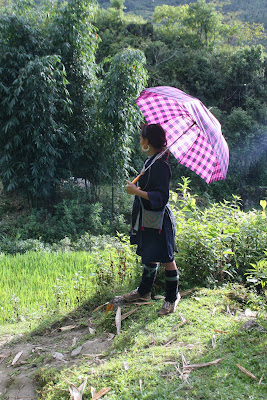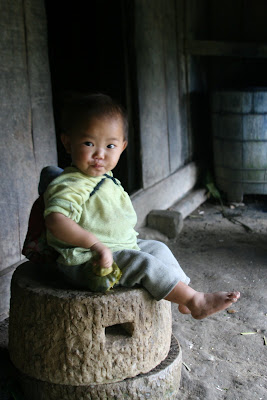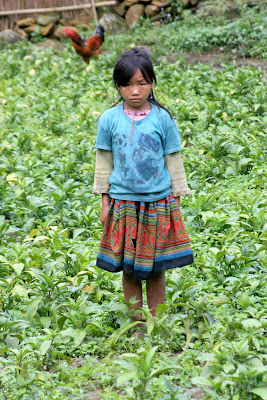The Accidental Trekker
Sapa has a particular kind of magic. Its mountains are living sculptures of rice terraces with rocky peaks. Clouds drift through villages and over roads, faster than fog, and just as quickly are gone.
These idyllic-looking landscapes are most inviting in Sapa's short summer, so I couldn't pass up the chance for a respite from the heat & hustling of Hanoi.
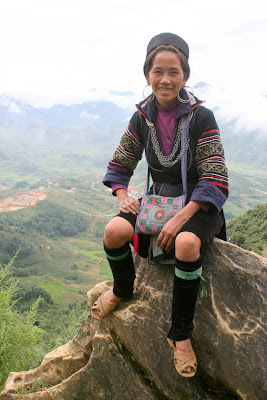
Chi's sister hanging out high & dry
Of course, this is Vietnam, and Sapa has its own brand of hustling. A lovely lady accompanied her sister (my guide) and me to their village, then pulled out a bag of assorted handmade trinkets, and said with a smile: "Buy from me?"
But how did I end up on this hillside with these H'mong ladies, sweating over slippery rocks and grassy slopes?
It was all thanks to May (pronounced "Mai", like "Chiang Mai") and her American husband Martin. I met Martin my first morning in Sapa while I sipped a ca phe da to wake up after the overnight train from Hanoi. He and May showed me around and cooked fantastic meals of H'mong rice, tofu, and vegetables.
"You want to stay overnight in my friend's village?" Martin asked one day. I hesitated, having planned to hire a motorbike driver and stop briefly in several villages instead: minimal sweating and more village variety. I looked down at my silk shirt and slippery sandals and asked, "Is it ok to wear this? I can't trek in these shoes though!" Martin waved off my ridiculous question and went off to find his friend.
The next morning, I met my guide-to-be at the market. "Hi, my name Chi!" she said with a gigantic smile. She didn't look a day over twelve. "No, I'm eighteen and have a baby girl, you will meet her soon. Ready to go?" she asked.
I nodded, looking vainly for a motorbike. "Okay, let's walk," she said, and pointed her deadly-looking umbrella to our left. No point arguing with this H'mong Mary Poppins. Ever the clueless tourist, I followed on foot, wishing I'd picked up a pair of boots from the trekking shops in town.

Chi's husband & his brother, herding a buffalo home
"How far to the village?" I panted after awhile, as the paved path turned to slick rocks and a daunting incline of mud splattered with buffalo patties. "Maybe six kilometers more," Chi said over her shoulder. "You want my umbrella?"
So that's what these umbrellas were for: an ideal walking stick to guard against sun, rain, and treacherous trails up mountainsides.
It turns out their village was so small and remote, no motorbikes could reach the place. A cluster of homes - each one nearly self-sufficient with a small garden, buffalo, pigs, geese and dogs - made up their small community.
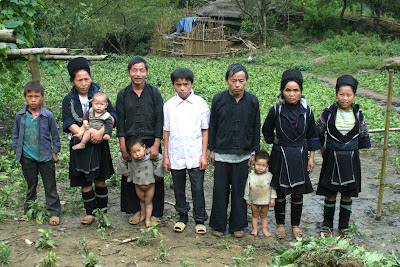
Neighbors in their indigo-dyed best
Chi had me hang out with the neighbors for awhile - she still had cooking responsibilities to her husband's family. The neighbors loved their rice wine, and were in their cups before sunset. Though I prefer to point my camera at unexpected objects rather than predictable portrait shots, they asked me to take photos and give them printed copies before I left.
Smoke from the bamboo fire filled the chimney-less house, and it was a relief to head back to Chi's less-smoky place for an early night.
The next morning, Chi's daughter Bam marched around the house, wearing her "baby": a towel wrapped snugly in a harness just like the one she's carried in by her mom. Here she's sitting on a traditional rice grinder. In Hong Kong, they're sold as decorations. In Chi's village, it's a part of everyday life.
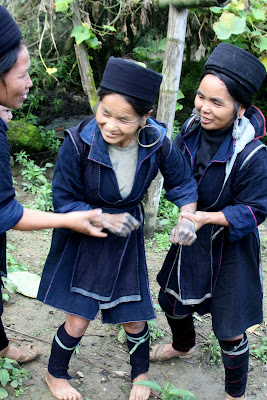
Ladies next door. Note the indigo-stained hands of the woman at center.
Chi said, "You know why she's not smiling? It's because the Vietnamese think a woman is most beautiful when she looks serious."
Bam is named after a lovely local flower. Here she's chewing on some sugarcane.

Chi weaving hemp at her mother's house
Homestays are a lucrative business in parts of Vietnam, particularly in the northern hilltribe and Mekong delta regions. They're touted as an "authentic" way for travellers to experience daily lives vastly different from their own.
But how authentic are they really? Certain flashpacker homestays I saw on travels through villages close to Sapa town were simply guesthouses in villages, with meals cooked by a local family. Guests stay in sanitized homes with running water and concrete floors. But the village where I stayed, with its absence of toilets and bathing facilities, its dirt floors and chickens underfoot, was no more a genuine experience of Sapan hilltribe life than those village guesthouses.
Had I been invited to the village for a festival or by someone with whom I'd had some sort of prior relationship, it would've been a different premise for my presence there. As it was, I was a wealthy voyeur paying the equivalent of more than a month's local wages to spend the night with a family I'd never previously met.
I remembered my Cambodian photo student's embarrassment when, one day we walked with our cameras, he pointed out the illegal shack his family lived in next to the river. The Macedonian classmate in Bangkok who had no embassy to call on for help when he needed it most. The retired sailor in Cuba with whom I'd shared a cigarette: he'd had a wonderful one-night stand in Boston fifty years before, yet he would never be allowed to leave his country again.
We have escape routes and assumptions we never realize until meeting others who are denied them, but a homestay is a pay-per-view version of real human encounters.
 ThingsAsian
ThingsAsian

